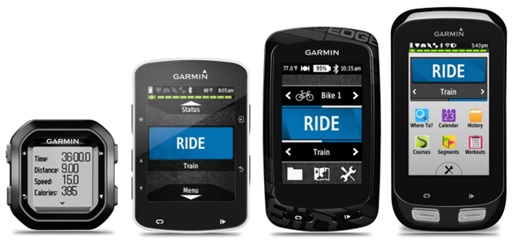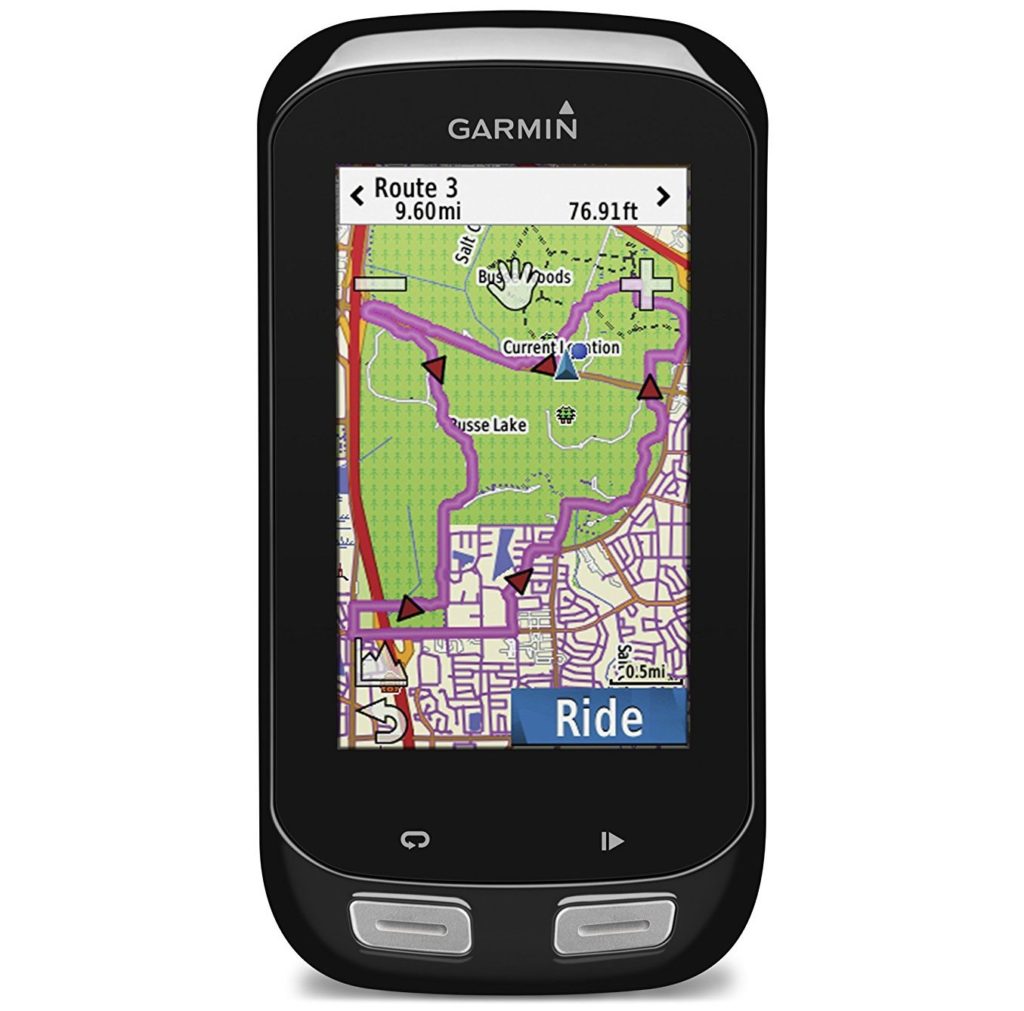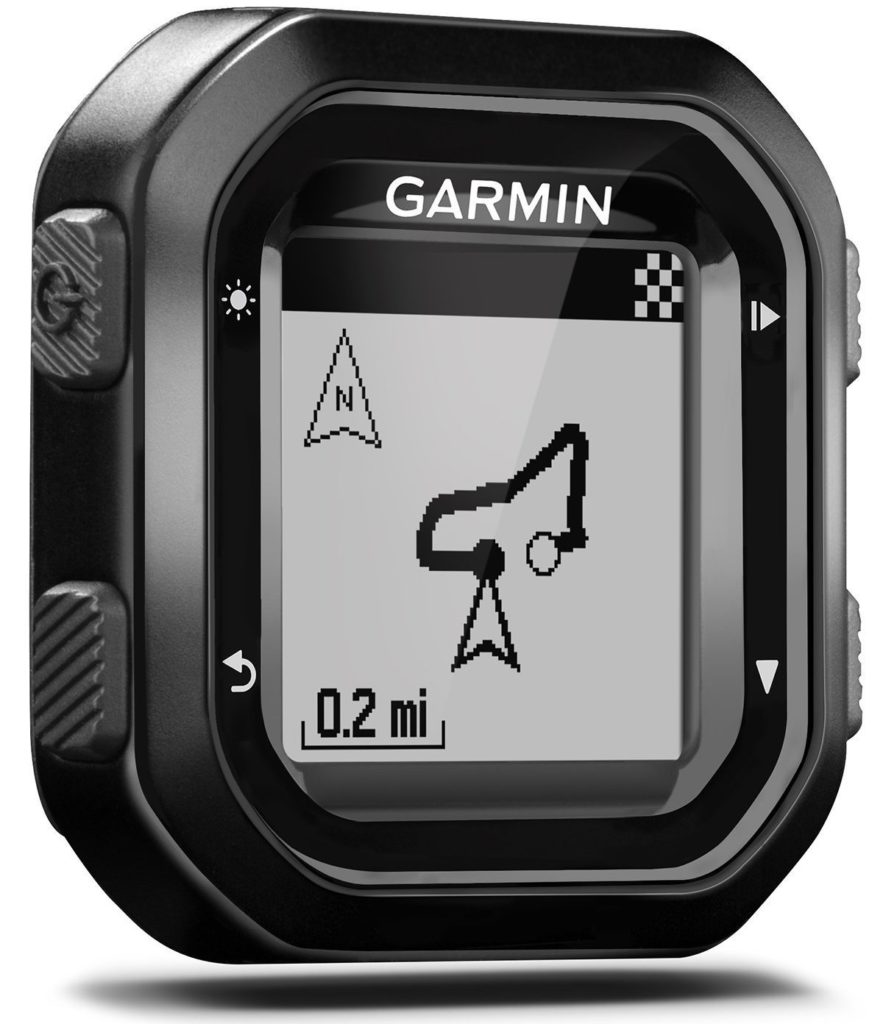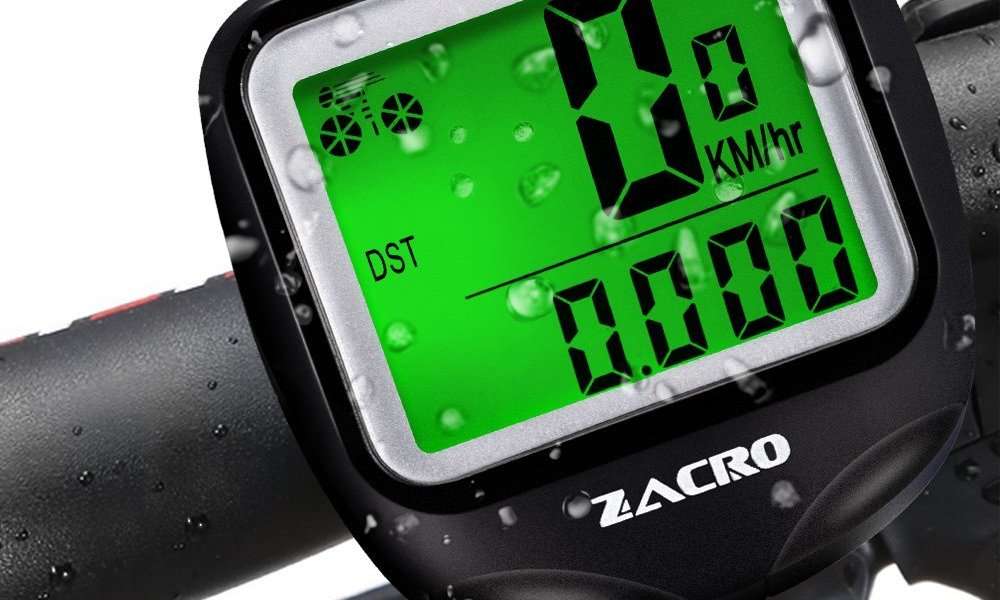- You are here:
- Home »
- Bike Computers
Category Archives for Bike Computers

Garmin Bike Computer Buying Guide: Best Models & Top Reviews for 2017
Created for a diverse array of cyclists including endurance riders and performance racers, GPS-integrated bike computers are the latest wave in the hottest biking accessories on the market, with sales steadily growing as these cutting-edge devices continue to develop a wildly popular fan base.
Used by cyclists for the main purposes of measuring riding distances and receiving turn-by-turn navigation and many are also taking advantage of the bike computer’s ability to track critically important information such as speed, maximum speed, average speed, time distance, speed cadence, and more as an astute method to gauge overall progress and gains.
Bike enthusiasts have quickly replaced their smartphones with bike computers as their device of choice during riding due to the newfound ability to quickly and effectively garner copious amounts of valuable data pertaining to performance and individual fitness.
In today’s modern times, the world of cycling has changed in myriad ways. With technology’s consistent advances, cyclists are presented with a multitude of equipment, devices, and options aimed at assisting them in becoming better athletes. Out of the plethora of choices available on the market, few if any have caught on with such ubiquitous popularity as the comprehensively favored bike computer.
With an extensive amount of detailed data at your fingertips, bike computers provide cyclists with more options than ever before to heighten their performance, gains, and ultimately, their level of fitness.
An exceptional tool for entry-level riders to up their cycling game, bike computers are equally appropriate for seasoned pros who use their device’s precise collection of data to push personal athletic boundaries, break individual records, and surpass previous levels of fitness.
If you are interested in learning more about bike computers, read on below for an easy-to-read primer on the device, its pros, and its cons to ultimately help you make the most educated and well-informed purchase decision possible.

Hungry for data? Garmin’s data-packed bike computer devices will satisfy even the most information-hungry fanatic. Even buyers purchasing Garmin’s entry-level Edge 25 bike computer will be amazed at the sheer amount of data and overall benefits the device provides, including but not limited to:
Edge 25
Amazing live tracking feature gives your family and friends the ability to track and view your ride’s progress in real time. | Includes powerful functions to capture a user's most important stats and includes valuable information such as ascent-related data, location, and heart rate measures that grow increasingly more accurate as you become fitter |
Offers social media options and ride planning capabilities through the Garmin Connect program | Users can receive smart notifications when the device is paired with a smartphone |
Water and weather-resistant | Records and tracks distance, time, speed, maximum speed, average speed, and user heart rate |
Integrated GPS with interconnectivity | Lightning-fast data upload |
Compact, small, powerful | Doesn’t drain the battery quickly like a cell phone; can be used for 8+ hours |
Edge 25 product details
Product price | Less than $150 |
Product dimensions | 1.6” x 1.6” x 0.7” |
Product Weight | 0.9 oz |
Display size | 0.9” x 0.9” |
The Edge 25 Bike Computer shown below is priced right near the starting point of Garmin’s pricing spectrum. In contrast, their Edge 1000 device is priced at the very top of the product range and features all of the features found in the Edge 25 with an incredible list of additions including, but not limited to the following:
Edge 1000
Over 200+ hours of stored history | 100 stored ride routes |
Wi-fi enabled | Users are able to add favorite maps |
Training and analysis features | Premium navigation and mapping functions |
Auto Pause and Auto Lap | Three preloaded round-trip ride options |
Virtual Partner | Weather alerts |
Expansive 3-inch, high-resolution screen | Includes “Vector” – Garmin’s own power meter that measures pedals to produce total power data |

Edge 1000 product details
Product price | Around $500 |
Product dimensions | 2.3" x 4.4" x 0.8" |
Product weight | 4.0 oz |
Display size | 1.5" x 2.6 |
Garmin’s full product range of bike computer includes nine different models featuring different price points, varying display screen sizes, and assorted integrated applications and accessories. Even the entry-level Edge 25 is a powerhouse device packed full of crucially important data that can serve to fundamentally transform the routines, workouts, and health of its users.
For those consumers who desire the creme de la creme, the Edge 1000 is the ultimate product choice. Brimming with all of Garmin’s most popular applications and accessories, the Edge 1000 is a dense 4-ounce device that exhibits the highest quality at every corner. Fitting snugly on bikes, the Edge 1000 is an essential component of the repertoire of the most dedicated of biking professionals seeking cutting-edge methods to surpass personal records and become athletes of even greater caliber.
To get started on making the right Garmin Bike Computer for yourself, consider the following questions:
What is your budget for a bike computer? Do you absolutely need the top of the line Garmin Edge 1000? Conversely, will a basic bike computer like the Edge 20 prove to be lackluster and inappropriate for your needs? Make your budget determination while taking into consideration your specific needs | What is your experience level? If you are new to the world of riding, an entry-level model like the Edge 20 or 25 will fit your needs perfectly by measuring your speed, distance, progress and much more. Seasoned riders will appreciate integrated functions that measure heart rate, output, elevation/ascension and cadence |
What types of data are important to you and how will you apply the data you receive? Do you require trip planning, wi-fi integration, or specific forms of analyses? | Have you looked into alternative devices such as a fitness monitor or using a cycling app on your smartphone? Would this be sufficient for your needs? Or do you require the highly specified information only a bike computer can provide? |
Cyclists of all skill levels are turning to Garmin Bike Computers as a way to enhance their athletic prowess and biking ability.
With their integrated GPS technology and abundance of tools measuring critically important information such as cadence, speed, duration, heart rate, ascension, and much more, Garmin Bike Computers are essential components for athletes to make point-by-point improvements in their performance based on the precision data they receive from their device.
With options ranging from around $100 to around $500, consumers can choose from nine different Garmin Bike Computer models to fit their highly specific and individual needs. With varying screen sizes, assorted applications and accessories, and a wide-range of training tools, Garmin's Bike Computers have the perfect option for every cyclist, from beginners to the sport, to seasoned professionals.

For more valuable information on the different kinds of Garmin Bike Computers available on the market today, visit us at bikingtribe.com.
With our crew of highly-trained specialists, we are among the leading sites online for information pertaining to bicycles, security, performance, and more.

Best GPS Bike Computer: Buying Guide & Top 5 Reviews for 2017
When you’re out mountain biking riding the trails, the chances are that you’ll want to have a GPS on you. Even better would be a bike computer with GPS built in as one of the many functions so that you will benefit from turn-by-turn navigation over any distance. Well, you can now have the best of both worlds!
But what should you look for in a GPS bike computer?
One of the biggest things that you should think about is if you want it just to give you GPS or if you want it also to track your ride and give you data so that you can review your ride later. The latter of these two types tend to cost more, but they also hold a lot of neat features (i.e., built in maps, larger screens, navigation software, power meter, heart rate monitor, etc.).
Do you want to be able to connect your phone to the device? You might want to be able to do this so you can share information about your trip, control music, have spoken navigation, have incoming calls and text alerts, and so much more. But it’s all personal preference here.
How do you want to be able to connect the device to your bike? Do you want to be able to have the device attach to your handlebars or the stem of the bike? There are also others that can be worn as wristwatches which tend not to be ideal for viewing while cycling.
Screen size is also something to consider: Larger screen sizes allow you to see more data at once than smaller ones do. But they also have the downside of being a lot bulkier, even though they do cut down on the amount of page navigating you’ll have to do.
All of these things depend on how you cycle and the trips that you take. If you’re truly curious about which features would be best for the type of cycling you do there is plenty of research out there that can help you out!
To get you started, here is a list of the top 5 GPS bike computers that you can find on the market today:
Garmin Edge 520 Bike GPS

Price: $249.99
Key Features:
- Offers in-ride challenges through Strava live segments
- Pairs with compatible indoor trainers for data display and control
- It has automatic uploads, live tracking, smart notifications, sends/receives courses, social media sharing, and weather functions
Pros:
- The screen size is large enough to take a quick glance while you’re riding but small enough that it doesn’t take over your handlebars
- Battery life lasts 8 hours, as long as you don’t have the backlight on all the time
- The GPS assistance works wonders if you’re riding around on tricky paths and trails
Cons:
- The configuration of information can be somewhat unreliable; it can sometimes leave the screen reading off gibberish
- There is a lot of lag time when it comes to maps updating, using the cadence sensor, and the maps tend to freak out when you go on a new trail
Cateye Stealth 10 Cycling Computer

Price: $94.63
Key Features:
- Quick and easy set up
- Doesn’t require a speed sensor or syncing
- Full-time backlight
- Waterproof
Pros:
- Build quality is excellent; the mounting bracket is easy to install and fits perfectly on handlebars or a stem mount
- This GPS is waterproof so you don’t have to worry if it gets wet while you’re on your ride
- The GPS can be scarily accurate if you go off on the side of the road too far or take a turn too tight; it knows exactly where it happened
Cons:
- Sometimes the GPS satellite technology can be iffy. It can lose signal in wooded areas
- The display can be a bit too detailed for some cyclists’ liking, but it’s something that can easily be learned to work with
Wahoo ELEMENT GPS Bike Computer

Price: $327.50
Key Features:
- Has a companion app that allows for easy configuration and setup
- You can enter any destination, address, or point of interest to get an optimized route for cycling
- Automatic route downloads
- Package includes Wahoo Element, out-front, stem and handlebar mounts, and a quick start guide
- Bluetooth compatible
Pros:
- Incredibly simple to setup and get started with, plus you can easily customize the features on this GPS bike computer
- The screen contrast is amazing, no matter the angle, the amount of sun, or glare you can easily see what is on the screen of this GPS
- Offers navigation with an audible “beep” and light to let you know if you’re off the path
Cons:
- The buttons are rather awkward and hard to press, especially while you’re on a ride
Garmin Edge 1000 Color Touchscreen GPS

Price: $459.00
Key Features:
- Large 3-inch display makes it easy for you to glance at it while on a ride
- Bluetooth compatible so you’ll get phone notifications
- Three different types of navigation:
- Preloaded maps and points of interest
- Round trip routing to explore new roads
- Route planner that lets you customize your trip
Pros:
- The display is large enough that makes it incredibly simple for anyone to glance down and see
- This GPS computer shows your speed, cadence, heart rate, route progress, weather, text messages, etc.
- This device is incredibly customizable
Cons:
- Bluetooth is only compatible with iPhone 4s and newer
- This device is rather expensive, but it’s a great investment for someone who’s really into biking and wants a completely customizable GPS bike computer
Lezyne Enhanced Super GPS Cycling Computer

Price: $149.99
Key Features:
- Bluetooth accessible for Android and iOS
- Display can be personalized to show whatever you want it to show – 5 customizable pages
- Battery life of 24 hours
- Large display, easy to read, and incredibly durable
Pros:
- You’ll be able to get incoming notifications through this device, which can be relatively helpful
- You won’t have any issues with this GPS bike computer losing connectivity even on the more desolate trails
- The battery life is as amazing as they claim, you can go about 5 hours of riding and use only 20% of your battery
- Incredibly easy to sync and upload the rides that you do
Cons:
- Some people have issues getting the GPS bike computer to record their trips, but you can always look up videos on how to get it going

Top 5 Best Wireless Bike Computer Reviews 2017
If you are an avid bike rider, or you just want to be able to track how far you go, your current speed, etc., when you’re on a bike ride, then a bicycle computer is a good thing to have. Bike computers help you keep a record of your bike trip and even help you learn from it.
Bike computers attach to your handlebars and will tell you your speed, how far you’ve gone, and allow for GPS if you choose to purchase one with that feature. Because there are so many features that you can find on a bike computer, none of them are the same whatsoever. It’s up to you to decide what features you want the most and which features you could live without.
Wireless bike computers are ideal because there isn’t the need to hide or contain a bunch of wires for the computer to work. They are easy to install, small, and they can easily be moved from one bike to another. One of the major downsides to a wireless bike computer is that most of them take batteries, which can become costly, annoying, and battery life is varied.
Since not all wireless bike computers are equal, which ones are the best for you and which should help you avoid? In this article, we’re going to go over five of the best wireless bicycle computers that you can find on the market today that is worth the money you’ll spend on them.
CatEye – Strada Wireless Cycle Computer

Price: $49.99
Key Features:
- Shows cyclists their current, max, and average speed, total trip distance, elapsed ride time, pace arrow, and clock
- Automatically knows when you’ve stopped and stops counting time and averaging speed
- The base is the only button you need; it allows you to toggle through all functions easily
- Easy to mount, adjust, and move
- You can switch it between bikes and it has a dual tire size
Pros:
- While this computer is tiny, it is incredibly accurate when it comes to your average speed, trip distances and time
- Incredibly easy to mount onto your bike and adjust if need be, all with your hand.
- Easy to change between functions while you’re going. Instead of a bunch of different buttons, there’s just the one that you need to hit
- It’s wireless, so you don’t have to try to hide the wires or move them out of the way
Cons:
- This computer does require batteries in order for it to work
- It’s easy to accidentally touch this computer and have all of your data erased or changed
- Removing the computer can be quite tough to do, it requires a lot of force and can erase your information in the process
CatEye Velo Wireless Cyclocomputer

Price: $40.00
Key Features:
- Comes in multiple colors
- Single button operation with eight functions
- Wireless sensor
- Provides current, average, maximum speed, trip distance, and total distance
- Has an auto start and stop, power save, and sleep mode
Pros:
- The quality of this product feels as though it is meant to last, cyclists won’t have to worry about it breaking suddenly
- There are so many features on this computer, all of them are easily accessible with the single button on the computer
- Once the magnet and sensor are securely installed onto the bike, it’s secured tightly. It’ll barely move, plus the sensor doesn’t require adhesive so there isn’t any residue left behind
Cons:
- After a couple of weeks, some buyers found that this computer stopped working. They found that the wireless connection was no longer working
Garmin Edge 25 GPS Cycling Computer

Price: $169.99
Key Features:
- One of the smallest cycling GPS computers in the world: Weighs only 25 grams
- Great GPS setting; tracks your location even under tree cover
- Connected features allow you to easily share details of your ride with friends via social media
- You can easily pair this with a heart rate monitor, cadence sensor, and speed sensor
- You can download courses, view personal records, and more
Pros:
- This unit is so simple to use, even the design of the computer itself is simple
- Incredibly compact, it’s the same size as a wristwatch
- The screen is easy to read; you can flip between a clock, a data screen, and a rough map of the path you’re traveling
- There’s a beep that lets you know that you’re flipping through pages and the buttons are large enough that you can easily touch them if you’ve got gloves on
Cons:
- You do need to buy additional add-ons if you want to be able to track your heart rate or speed
Lezyne Mini GPS Bike Computer

Price: $129.00
Key Features:
- Has GPS option
- Tracks your speed based on current, average, and maximum speed
- It has 100 hours of memory on it
- Very small and easy to install
Pros:
- Easy to use and set up
- Battery life is good, especially considering it does take batteries
- Easy to switch between bikes if you need to
- Easily saves maps, your mileage, and vertical feet climbed
Cons:
- The GPS does require some time to connect to a signal
Garmin Edge 520 Bike GPS

Price: $249.99
Key Features:
- Offers in-ride challenges through Strava live segments
- Pairs with compatible indoor trainers for data display and control
- It has automatic uploads, live tracking, smart notifications, sends/receives courses, social media sharing, and weather functions
Pros:
- The screen size is large enough to take a quick glance while you’re riding but small enough that it doesn’t take over your handlebars
- Battery life lasts 8 hours, as long as you don’t have the backlight on all the time
- The GPS assistance works wonders if you’re riding around on tricky paths and trails
Cons:
- The configuration of information can be somewhat unreliable; it can sometimes leave the screen reading off gibberish
- There is a lot of lag time when it comes to maps updating, using the cadence sensor, and the maps tend to freak out when you go on a new trail

Zacro Bike Computer BC370 Review
Is the Zacro BC370 as good as the previous version? If you’re not familiar with the Zacro, there is an older version of this device which is known for its quality and accuracy. The question is, is the BC370 as good as that one? We got our hands on the BC370 and here are our findings.
Features
- The Zacro is equipped with a powerful magnet for more accurate data recording.
- The unit comes with a couple of backup batteries for a longer lifespan.
- It has a large LCD display, which makes it easy to read the data. The numbers are also extra-large so you can glance down and monitor your progress.
- The Zacro bike computer sports a lightweight design so it is easier to mount on your bike and get started.
- The computer provides accurate information on all the essential data including average speed, top speed riding time, and more. With the Zacro, you’ll have an easier time monitoring all the essential details of your ride.
- The Zacro backlights can be configured so it appears white or green. Whichever you prefer. You’ll have a simpler time reading the data, even if it is dark.
- The unit is built for use on a wide range of bikes. You can install the bike computer on mountain bikes, regular bikes, road bikes, and others.
- Apart from the computer you also get a compass key ring, a holder, rubber band, and the cable ties.
Pros
- Long battery life
- Water resistant
- Portable
- Durable housing
Cons
- Instructions have to be read fully before you can use it
- Sensors and magnet have to be close to each other
Performance and Usage
The Zacro Bike Computer BC370 delivers the kind of performance you would expect from a high quality product. The Zacro has detailed instructions, and you will want to follow them for info on how to mount the unit on your bike. Once the BC370 is installed, you can start using it with your bike without making other adjustments.
The BC370 has the basic features a rider needs plus a few more. The Zacro records your speed along with your total mileage. You also get your average driving speed as well as your stop speed for this ride.
The large display makes it easy to read driving time, and it displays time in 24 or 12 hours. The BC370 also has automatic switching from sleep to wake mode, and it will notify you when the device requires maintenance.
The unit runs on CR2032 batteries, and the unit makes good use of its power. The batteries are easy to replace, and they’re widely available too. After setting the Zacro up, you’ll be able to avail of its large LCD display and view the data.
There is no mystery to the way the unit works. You screw the magnet on any of the wheel spokes and mount the sensor on the front wheel fork. The display obtains information off the sensor and displays it on the screen.
The display mounts securely so it’s not going to come off, even if you encounter a few rough spots. It may take a bit of time to get the set up right, but it is worth it as the computer is accurate. Just like with other bike computers, you have to calibrate the Zacro so it knows the size of your bike’s tires.
Once the Zacro knows the specs of your bike’s tires, it will do the rest. You just get on your bike and it will measure the distance, speed, and other details. Being able to read the distance in kilometers or miles is a nice feature and makes it easier to determine how well you are doing.
Should You Buy it?
If you’re looking for a reliable device that provides consistent performance, the BC370 is a good choice. It gives you clean, reliable results and it is also durable enough for use on different bikes under various terrains.
The BC370 is also suitable for anyone who wants a bike computer with all the hardware necessary to run the device. You don’t have to buy other accessories. The cable ties are bundled.
The Zacro is also ideal for riders who demand durability from the bike computer they use. Both the receiver/display and the transmitter/sensor are solidly made and can take a lot of punishment. After installation, the Zacro starts recording so you’ll know what to do.
Bottom line: The Zacro ibike computer provides the essential features you need without being complicated or difficult to use.
Verdict
The Zacro Bike Computer BC370 is a worthy upgrade and is way better than your standard bike computer. Even if you have never used a bike gadget before, the BC370 is easy enough to figure out, and it has the basic features a rider needs to keep track of their progress.
Given these benefits, we wouldn’t hesitate to recommend this product.
